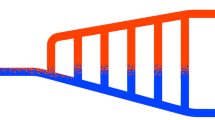Abstract
In this study, the bubble separation behavior in a gas–liquid separator is numerically investigated on the basis of the Euler–Lagrange approach, in which the forces acting on bubbles in a swirling flow field are modeled to calculate the trajectories of the bubbles. By adopting this approach, the effects of five parameters, namely, back pressure, Reynolds number, bubble diameter, void fraction, and swirl number, on separation performance in terms of pressure loss, separation efficiency, separation length, and split ratio are computed and analyzed. On the basis of the analysis, correlations of separation length with the two main parameters are established, which can serve as a basis for the optimal design of separator.
Similar content being viewed by others
References
S. Juengjaroennirachon et al., Performance enhancement of air conditioning using thermosyphon system’s energy storage unit for cooling refrigerant before entering the condenser, Journal of Mechanical Science & Technology, 31 (1) (2017) 393–400.
Q. Lv, H.-C. Lin, S. Shi, X. Sun, R. Christensen, T. Blue, G. Yoder, D. Wilson and P. Sabharwall, Experimental study of DRACS steady-state and transient performance, International Congress on Advances in Nuclear Power Plants, San Francisco, CA, Apr. (2016).
H.-C. Lin, Q. Lv, S. Shi, X. Sun, R. Christensen, T. Blue and P. Sabharwall, RELAP5 model validation and benchmark for DRACS thermal performance, International Congress on Advances in Nuclear Power Plants, San Francisco, CA, Apr. (2016).
M. Chen, X. Sun, R. Christensen, S. Shi, I. Skavdahl, V. Utgikar and P. Sabharwall, Design and testing of helicallycoiled fluted tube heat exchangers for FHR applications, 11th International Topical Meeting on Nuclear Reactor Thermal Hydraulics, Operation and Safety, Gyeongju, Korea, Oct. (2016).
H. Li et al., Performance of a gas-liquid separator under different back pressure, Nuclear Techniques, 38 (1) (2015) 10603-010603.
T. S. Kress, Mass transfer between small bubbles and liquids in cocurrent turbulent pipe flow, Tennessee: University of Tennessee (1972).
C. H. Gabbard, Development of a venturi type bubble generator for use in the molten-salt reactor xenon removal system, Oak Ridge National Laboratory (ORNL), Oak Ridge, TN (United States) (1972).
J. L. Yin et al., Study on the air core formation of a gasliquid separator, J. Fluids Eng., 137 (9) (2015) 091301.
W. K. Evans, A. Suksangpanomrung and A. F. Nowakowski, The simulation of the flow within a hydro cyclone operating with an air core and with an inserted metal rod, Chem. Eng. J., 143 (1-3) (2008) 51–61.
Y. Li et al., Cut to the combustion furnace of distribution of the swirl number test, Journal of Engineering Thermophysics, 22 (Suppl) (2001) 213–216 (S1).
J. M. Beer and N. A. Chiger, Combustion Aerodynamics, Second Ed., Krieger R. Publishing Company (1983).
N. N. Zhang et al., Bubble separator features in the molten salt reactor gas-freeing system, Nuclear Power Engineering, 35 (2) (2014) 137–140.
B. Q. Xiao, L. Ran and R. Guiwen, Based on the Euler Lagrange method of channel suspended matter deposition numerical simulation, Journal of Hydroelectric, 34 (9) (2015) 46–51.
J. R. Angilella and M. Souhar, Modeling and qualitative experiments on swirling bubbly flows: Single bubble with rossby number of order 1, J. Fluids Eng., 125 (2) (2003) 239–246.
T. R. Auton, The dynamics of bubbles, drops and particles in motion in liquids, Cambridge: Cambridge University (1983).
R. Clift, J. R. Grace and M. E. Weber, Bubbles, Drops, and Particles, America Press (1978).
Author information
Authors and Affiliations
Corresponding author
Additional information
This paper was presented at the ISFMFE 2016, LOTTE City Hotel, Jeju, Korea, October 18–22, 2016. Recommended by Guest Editor Hyung Hee Cho.
Tingting Zhang is an undergraduate student majoring in nuclear engineering at Shanghai Jiao Tong University. She is pursuing her Ph.D. degree at Shanghai Jiao Tong University, and her research interests include bubble dynamics and two-phase flow.
Dezhong Wang is a Professor at Shanghai Jiao Tong University, from where he received his Ph.D. degree. His research interests include fluid mechanics, key technology of nuclear power equipment, flow visualization, and laser measurement technology.
Rights and permissions
About this article
Cite this article
Zhang, T., Yin, J. & Wang, D. Numerical simulation of bubble separation length in a gas–liquid separator based on the Euler–Lagrange method. J Mech Sci Technol 31, 5123–5129 (2017). https://doi.org/10.1007/s12206-017-1006-3
Received:
Revised:
Accepted:
Published:
Issue Date:
DOI: https://doi.org/10.1007/s12206-017-1006-3




